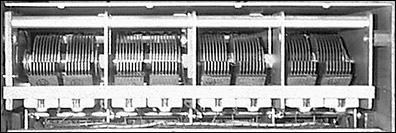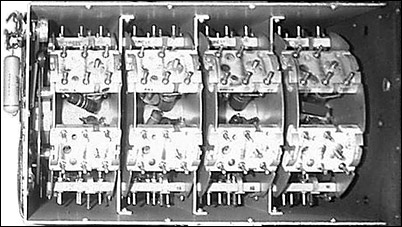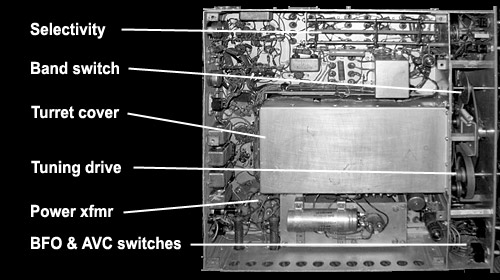
Top of RF deck, with cover plate off. We see the huge, 4-gang, tuning capacitor. Out of frame to the bottom are 4 gain stages using miniature tubes.
Properly working SP-600s are a joy to use, and with 20 tubes they keep your room nice and warm. Well restored, they will outlast anyone currently alive on this planet.
This is a big radio, both in size and weight, and it's built like a battleship. It could probably derail a train, though that would be a terrible waste of a good radio. The set weighs around 65 pounds. After it was crated and packed up for shipping, its official weight from the factory was a hellacious 220 pounds!
SP-600s are easy enough to come by, usually at surplus prices, though some are in better shape than others. Most have seen years of service and been knocked around a bit. A fairly decent surplus SP-600 won't set you back much, but they are NOT cheap to ship. Also, keep in mind that these things are 50 years old. This adds to their appeal, but it also means they will invariably need some work.
You WILL want to come by a manual for your SP-600. They are available from various sources on the Internet, either by snail mail, eBay, or download (huge). The best thing to do is find one for your particular version of the circuit (more on type variants later), but that's often easier said than done.
Identification
Once the top plate, if any, is off your SP-600, you should be able to see a nameplate in the middle of the cover on the RF deck. This is important. It has the type designator for your particular variant of this radio, and the serial number. The serial numbers have a couple of weird sequences.
In SP-600 model numbers, the J means it has JAN (military grade) parts. The X means that there are a couple of extra switches for crystal frequencies. An L means it tunes a lower range, often skipping AM broadcast, and the rare -VLF tunes 10 to 540 kHz!
Following the letters, there is the type number. Hammarlund produced a bewildering array of nearly 40 variants for different contracts. With only a few exceptions, these have sequential model suffixes. Les Locklear has produced a comprehensive (and copyrighted) table of these, which you can get here.
One widely encountered variant is the SP-600-JX-17 with a few distinctive red knobs, originally used by the Air Force for diversity reception. Another is the Navy's R-274B/FRR, a JX-6 (and some later series) with a crystal trimmer and a wider BFO range of 0-10 kHz. An Army version frequently has a 25-60 Hz power supply.
The receiver was intended to drive 600-ohm audio lines (like the R-390/390A), or to feed RTTY loops. They tended to be used in multiples, either for diversity or different bands, so a lot were sold. They were also used for surveillance, with the audio connected to various recording devices (including, in one case, a video machine). The FBI and CIA both used the SP-600.
Design Overview
The SP-600 was designed to fit a standard 19" rack. The manuals and ads show pretty pictures of the SP-600 in a nice rack box, optional at extra cost. The standard size box will not work, because the SP-600 has a deeper chassis than, say, the R-390. Hammarlund sold a box that would fit, as did Hallicrafters and at least one other company. You can still come by these used, but they may be a bit pricey. On eBay, SP-600 racks go for nearly as much as unrestored SP-600s.
The circuit is a relatively ordinary superheterodyne, with a tuned first conversion oscillator and double conversion on the high bands. It's an interesting implementation, though. There's a lot of attention to shielding, proper gain staging, and mechanical quality, making it a superb performer on AM, MCW, CW, and RTTY. Quite a few modifications of this receiver exist, both in the field and by order from the manufacturer.

Top of RF deck, with cover plate off. We see the huge, 4-gang, tuning capacitor. Out of frame to the bottom are 4 gain stages using miniature tubes. |
The crystal filters do a nice job on CW. If you've never used this type of filter to make weak stations pop out of the noise, get ready for a treat as you experience what a real CW radio can do.
Bandswitching is by a turret-style tuner, somewhat resembling a larger version of the ones in old TVs. It connects the appropriate set of coils and circuit elements via spring-loaded contacts to an RF deck, while moving a really cool pointer device up and down to the appropriate band. The advantage for us is that there is no wafer switch to oxidize or break, thereby screwing up the whole radio. The disadvantage is a certain increased mechanical complexity when working on the thing.

Bottom of RF deck, with cover plate off. Each of the small white modules holds a tuned circuit and contact points that switch in the appropriate parts to accomplish band changing. The band switch knob rotates this entire turret by means of a drive mechanism. |
Audio output is about 2.5 watts, nominally from a 6V6. This goes to a tapped transformer and an output strip. It'll drive a speaker, though the 600-ohm line will need to be matched to the more normal 4, 8, or 16 ohms. You can use 70.7 volt public address transformers for this, at a considerable cost saving.
The audio is high-fidelity by communications receiver standards, but deliberately rolled off at 200 Hz for voice intelligibility. There are audio mods around that make small circuit and capacitance changes to restore the bottom octave of music, and/or add inverse feedback. It is said to sound great into an efficient, full-range, hi-fi speaker like the Altec 604.
Only the very last SP-600 variant, the JX-21A, ever had a SSB product detector. This one has selectable sideband and two additional tubes for a total of 22. Other radios used the really nice, rack-mounted, SPC-10 adapter. This plus the rack-mount SP-300 speaker make a nice impressive wall of gear, as shown in ads of the time. Of course, you can just turn on the BFO for sideband, though there'll be the usual IF compromises that reduce intelligibility and tuning ease.
Servicing
Most of the SP-600s that turn up used need some restoration, if they haven't been worked on already. If you don't know how to revive old tube boxes, find someone who does. If the set hasn't been powered-up in a long time, the usual precautions about gradual voltage raising apply, unless you like seeing smoke come out of old radios. Once you're finally up to operating voltage you'll be able to see what's wrong with your set. With any luck, it'll just be very tired and somewhat out of alignment. If other problems appear, you'll need to troubleshoot them using the manual, schematic, voltages, and resistances.

The older SP-600s, which are unfortunately the majority of those turning up surplus, used the dreaded "Black Beauty" type of tubular capacitors. At some point, Hammarlund caught on to the short life of these, and switched to ceramic. Pre-ceramic sets will need a full re-capping, requiring some disassembly of the turret and RF deck. These are not the simplest things to get apart - be careful, don't break the coils, follow the directions that are all over the Internet, and label all hanging wires!
There are something like 55 caps that have to go, depending on the individual variant. Do them all, because it dramatically perks up these old soldiers. Some of them are pretty hidden, inside IF cans or behind things. Do them anyway. Here's one guy's account of how he did it, though most people will need a LOT more time. I've found that re-capping old short wave radios is not a good undertaking for anyone in a hurry. While your set is apart, also check resistors which might have been zapped by the bad caps.
The tuning on this radio should be way the best flywheel drive you ever used. If it isn't so velvety-smooth as to border on sensuous, the spring in the flywheel mechanism may have lost its tension with age. Re-tensioning it will restore your sexy radio.
Finally, this is such a handsome set that it's good to clean everything up real nice. Fortunately, most radios were used indoors, and on dry land. The chassis insides often have a yellowish/brownish anti-fungus spray. If the dial scales are too grungy to salvage, a couple of Internet users have graphics for their replacement.
The current preference in radio restoring is not to paint anything you don't absolutely have to, and then only to match the old colors as close as possible. Just touch up dings, rust spots, etc, and get everything relatively pretty. This starts to look like art, but it's also kind of a guy thing.
Have fun with your huge old radio.
Other References
Here are some of the many good SP-600 links: